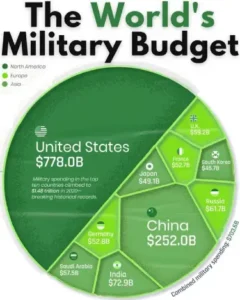Introduction: Unpacking the U.S. Military-Industrial Complex
The United States boasts the world’s largest and most lavishly funded military, surpassing the combined military expenditures of the next ten countries. This extensive funding prompts urgent questions about who receives help from such expenditure and at what cost to American taxpayers and global peace. This article explores the ramifications of the U.S. military-industrial complex, investigating how it shapes American foreign policy, affects economic priorities, and influences global stability.
The Evolution of the Military-Industrial Complex
Origin and Historical Context
President Dwight D. Eisenhower first warned of the military-industrial complex in his 1961 farewell address, cautioning against the unwarranted influence of a coalition formed by the defence industry, the military, and lawmakers. This alliance, he argued, could buy excessive power, steering the nation towards a war economy that prioritizes weapons and conflict over public welfare. This section traces how this complex has expanded from its Cold War origins to dominate aspects of American life, embedding itself within political, social, and economic fabrics.
Network of Influence
The military-industrial complex today is an entrenched network of influence that includes not just arms manufacturers and the military but also extends to Congress, think tanks, and media outlets. These groups collectively advocate for heightened military readiness and increased defence budgets, often irrespective of actual national security needs. This interconnectedness ensures the persistence of a policy environment that favours ongoing military engagement and substantial arms development, reinforcing a cycle of dependency on military spending.
The Scale of U.S. Military Spending
Analysis of the Current Military Budget

The U.S. military budget for 2021 was a staggering $800.67 billion, constituting over 3.48% of the nation’s GDP and 64.5% of all discretionary spending. This allocation supports a broad spectrum of activities, from personnel and operational costs to advanced research and new weaponry. However, when combined with other security-related expenses like veterans’ affairs, homeland security, and foreign military aid, the total expenditure approaches $887 billion, a figure that dwarfs the military spending of close rivals.
Comparisons and Global Footprint

The United States keeps a military presence far exceeding that of any other nation, with over 800 bases in more than 70 countries. This extensive network, while a relic of past geopolitical strategies, is a significant financial commitment that many critics argue is no longer justifiable. The maintenance of these bases incurs about $100 billion annually, a hefty price for a strategic advantage that is often debated within the context of contemporary global threats.
Issues of Waste and Inefficiency
Highlighting Financial Mismanagement
Despite the enormous budget, the U.S. military’s spending efficiency is repeatedly called into question. Reports from the Pentagon’s own audits reveal troubling financial discrepancies, including untraceable expenditures amounting to trillions of dollars. Programs like the F-35 fighter jet exemplify the chronic inefficiencies, experiencing massive cost overruns and delays while not delivering promised capabilities, which suggests a deeper problem of oversight and accountability within defence spending.
The Broader Impact on Society and Democracy
Democratic Erosion and Perpetual Warfare
The influence exerted by the military-industrial complex on American democracy is profound. By funnelling enormous sums into lobbying and campaign contributions, defence contractors and their allies effectively shape legislative priorities, often skewing them towards continuous military engagement rather than addressing more pressing domestic issues. This focus diverts attention and resources from critical social programs and infrastructure, perpetuating a state of warfare that undermines global stability and stokes international conflicts.
Reassessing National Priorities
The argument for realigning national security spending with actual security needs has never been more potent. Advocates for change argue for a re-evaluation of what genuine security looks like, suggesting that investments in education, health care, and infrastructure could yield more substantial returns for societal well-being than equivalent investments in military hardware.
Conclusion: Rethinking America’s defence Strategy and Implications for Australia
The necessity to rethink the U.S. military-industrial complex is clear. As debates continue over the proper level of military spending, the need for a shift towards a more balanced approach to national security—that prioritizes long-term peace and stability—is paramount. This discussion is not only relevant to the U.S. but also serves as a crucial lesson for allies like Australia, which often aligns closely with U.S. foreign policy.
Lessons for Australia: Avoiding the Path of Excessive Militarization
The U.S. model of heavy military spending and global military presence has not only been a massive financial burden but has also often led to prolonged conflicts without clear benefits to national security or global stability. Australia, while a much smaller nation, faces similar pressures to increase military spending, particularly in response to rising geopolitical tensions in the Asia-Pacific region. However, it is essential for Australia to consider the long-term implications of following a similar path.
Australia should strive for a defence strategy that ensures national security while also promoting stability in the region. This involves a careful assessment of defence needs versus the potential risks of escalating military spending, such as increased regional tensions and the opportunity costs to other critical areas of public spending like healthcare, education, and infrastructure. By learning from the U.S. experience, Australia can aim to support a robust defence that is effective yet measured and not overly influenced by the profitability motives of the military-industrial complex.
Engaging in this discussion is crucial for ensuring that future defence strategies in both the U.S. and Australia reflect realistic security needs and promote a more peaceful global environment. It’s imperative that policy decisions are guided by a commitment to peace and stability rather than the interests of defence contractors and other powerful players within the military-industrial complex.
Question for Readers
How do you think reducing military spending could affect social and economic programs in the U.S., and what lessons can Australia draw from this to avoid the pitfalls of excessive militarization?
Call to Action
Be a part of this critical conversation about the future defence strategies of America and Australia. Share this article to foster debate and encourage a comprehensive re-evaluation of national security priorities.
References:
- War fever and the military-industrial complex: https://johnmenadue.com/war-fever-and-the-military-industrial-complex/
- Military-Industrial Complex: Military-Industrial Complex (history.com)
- Microsoft Bing Search: United States military-industrial complex – Search (bing.com)
- Military-industrial complex: Military-industrial complex | Definition, Elements, Influence, & Facts | Britannica
- 50 insights into the US military-industrial complex: 50 Insights Into the US Military-industrial Complex | Stacker
- Military budget of the United States: Military budget of the United States – Wikipedia
- U.S. Military Spending/Defence Budget 1960-2023: U.S. Military Spending/Defense Budget 1960-2023 | MacroTrends
- The Militarized Budget 2020: The Militarized Budget 2020 (nationalpriorities.org)
- The US spent $877 billion on military in 2022, a new report says — more than 10 times federal education spending: US Spent $877B on Military in 2022 — More Than 10X Education Spending (businessinsider.com)

